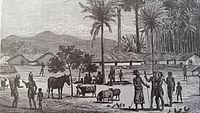Manyema

Manyema (WaManyema) (Una-Ma-Nyema, eaters of flesh)[1] are a Bantu ethnic group, described in the past as powerful and warlike,[1] in the African Great Lakes region of Eastern Africa and Central Africa.
Similar ethnic groups emerged as a result of an “intermingling of Hamitic and Negro types”[2] in the region, namely ethnic groups around Lake Victoria.
Many Manyema, like many Nyamwezi, are the descendants of porters who emerged during the height of the Swahili-Arab trade in the Sultanate of Utetera.[3] The area was extensively incorporated into Swahili economy and culture.[4]
During the early to mid-1800s, many Manyema traversed, back and forth, across Lake Tanganyika towards the Swahili coast in larger numbers as caravan porters, merchants, mercenaries, war refugees (emphasised in Manyema memories), slaves (emphasised by missionaries and colonial officials), and to some extent as slave traders (emphasised by explorers like Henry Morton Stanley, David Livingstone and John Speke).[5]
Many Manyema merchants traded slaves, ivory and gold. The New York Times reported that the Manyema “allied themselves with the Arabs”,[6] a misnomer applied to Waungwana.
Usually, a Manyema man would typically have children who are also identified as Manyema from birth. Similarly, children of Arab men would be identified as Arab. However, a female Manyema would often give birth to a child of various ethnicities, such as Swahili, Zaramo, Shihiri, or Arab. Thus, she may have multiple children, each with a different ethnicity that differs from her own[7]
WaSwahili in Ujiji town on the border between Tanzania & Democratic Republic of Congo, many of whom originally Manyema, identified themselves as Swahili.[8]
In Tanzania, the Manyema include various smaller ethnic groups of Congolese origin of which are independent culturally but with some resemblance due to intermarriages.
See also
[edit]- Hamites
- Banyarwanda
- Swahili people
- Tippu Tip
- Kasongo
- Nyangwe
- Sultanate of Zanzibar
- Sultanate of Utetera
- Congo–Arab War
- Congo Free State
- Jiji people
References
[edit]- ^ a b Chisholm, Hugh, ed. (1911). . Encyclopædia Britannica. Vol. 17 (11th ed.). Cambridge University Press. p. 626.
- ^ Bourne, Henry Richard Fox (1903). Civilisation in Congoland. P.S. King & son.
- ^ Nimtz, August H. (1980). Islam and Politics in East Africa: The Sufi Order in Tanzania. U of Minnesota Press. p. 9. ISBN 978-0-8166-5836-7.
- ^ Fage, J. D.; Oliver, Roland; Oliver, Roland Anthony; Sanderson, G. N. (1975). The Cambridge History of Africa. Cambridge University Press. p. 553. ISBN 978-0-521-22803-9.
- ^ Zöller, Katharina (June 2019). "Crossing Multiple Borders: 'The Manyema' in Colonial East Central Africa". History in Africa. 46: 299–326. doi:10.1017/hia.2019.6. S2CID 166482195.
- ^ "Article 17 -- No Title". The New York Times. 9 February 1890.
- ^ Decker, Corrie (2014). "Introduction". Mobilizing Zanzibari Women. pp. 1–20. doi:10.1057/9781137472632_1. ISBN 978-1-349-69080-0.
- ^ Lindström, Jan (2019). Muted Memories: Heritage-Making, Bagamoyo, and the East African Caravan Trade. Berghahn Books. p. 266. ISBN 978-1-78920-173-4.
